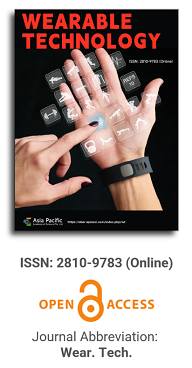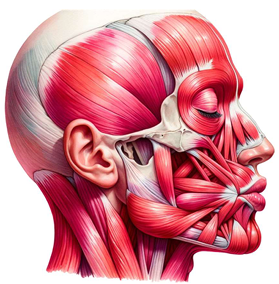

This paper delves deeply into the innovative realm of integrating human emotions with wearable technology. The primary focus is on the conceptualization and development of a kiss transfer device that harnesses the power of wearable technology to bridge the physical gap in human-human interactions. By investigating the intricate nuances of the human-human kissing process, the research seeks to replicate this intimate gesture through a technological medium. The paper not only elaborates on the anatomy, evolution, and hormonal dynamics of kissing but also underscores the transformative potential of wearable technology in capturing and transmitting these intimate moments. This exploration opens up new horizons for long-distance relationships, offering a tangible touchpoint that goes beyond traditional communication methods. Through this pioneering work, the research positions wearable technology as not just a tool for communication but as an extension of our human emotions and expressions.

The use of digital technologies in the sport and physical education lesson: Fostering need-supportive behaviours in physical education teachers
Vol 5, Issue 1, 2024
Download PDF
Abstract
In primary and high school settings, the benefits of incorporating technology into curricula have been addressed by several studies; however, wearable technology integration as experienced by physical education teachers is less prevalent. Physical education teachers’ lack of confidence teaching P.E. using wearables, along with a lack of appropriate preparation and unclear curricula frameworks that define how wearables could be used, are additional factors which require further exploration. As such, due consideration of the opportunities and barriers that physical education teachers encounter with wearable usage is presented. This article contributes to pedagogical practices in physical education using wearable technology. This is achieved by highlighting the opportunities that wearable technology presents as a student learning support tool as wearable allow cross curriculum learning opportunities with science, technology, engineering and mathematics. In this paper, the practicality and curriculum relevance of wearable usage in physical education is highlighted. Our paper discusses implications for research and practice and provides a knowledge base for the establishment of professional development courses based on teacher needs.
Keywords
References
- Thelen E, Schöner G, Scheier C, et al. The dynamics of embodiment: A field theory of infant perseverative reaching. Behavioral and Brain Sciences. 2001; 24(1): 1-34. doi: 10.1017/s0140525x01003910
- Piaget J. Science of education and the psychology of the child. Trans. D. Coltman. Orion. 1970.
- Roetert EP, Jefferies SC. Embracing Physical Literacy. Journal of Physical Education, Recreation & Dance. 2014; 85(8): 38-40. doi: 10.1080/07303084.2014.948353
- Prince SA, Adamo KB, Hamel M, et al. A comparison of direct versus self-report measures for assessing physical activity in adults: a systematic review. International Journal of Behavioral Nutrition and Physical Activity. 2008; 5(1): 56. doi: 10.1186/1479-5868-5-56
- Yang CC, Hsu YL. A Review of Accelerometry-Based Wearable Motion Detectors for Physical Activity Monitoring. Sensors. 2010; 10(8): 7772-7788. doi: 10.3390/s100807772
- Sousa AC, Ferrinho SN, Travassos BF. The Use of Wearable Technologies in the Assessment of Physical Activity in Preschool- and School-Age Youth: Systematic Review. International Journal of Environmental Research and Public Health. 2023; 20(4): 3402. doi: 10.3390/ijerph20043402
- Girginov V, Moore P, Olsen N, et al. Wearable technology-stimulated social interaction for promoting physical activity: A systematic review. Lu Z, ed. Cogent Social Sciences. 2020; 6(1). doi: 10.1080/23311886.2020.1742517
- Salmon J, Arundell L, Hume C, et al. A cluster-randomized controlled trial to reduce sedentary behavior and promote physical activity and health of 8-9 year olds: The Transform-Us! Study. BMC Public Health. 2011; 11(1). doi: 10.1186/1471-2458-11-759
- Mavilidi MF, Mason C, Leahy AA, et al. Effect of a Time-Efficient Physical Activity Intervention on Senior School Students’ On-Task Behaviour and Subjective Vitality: the ‘Burn 2 Learn’ Cluster Randomised Controlled Trial. Educational Psychology Review. 2020; 33(1): 299-323. doi: 10.1007/s10648-020-09537-x
- Almusawi HA, Durugbo CM, Bugawa AM. Innovation in physical education: Teachers’ perspectives on readiness for wearable technology integration. Computers & Education. 2021; 167: 104185. doi: 10.1016/j.compedu.2021.104185
- Taylor KH, Hall R. Counter-Mapping the Neighborhood on Bicycles: Mobilizing Youth to Reimagine the City. Technology, Knowledge and Learning. 2013; 18(1-2): 65-93. doi: 10.1007/s10758-013-9201-5
- Sherin MG, Russ RS, Sherin BL, Colestock A. Professional vision in action: An exploratory study. Issues in Teacher Education 2008; 17(2): 27-46.
- Lyons L, Silva BL, Moher T, et al. Feel the burn. Proceedings of the 12th International Conference on Interaction Design and Children. Published online June 24, 2013. doi: 10.1145/2485760.2485791
- Evans S, Willis C, James, D, Lee J. Fun, Fitness and STEM in Remote Indigenous Communities: a STEMfit Approach. 2023. Presented at the National Youth Sport Conference, November 2023, Adelaide, Australia.
- Chu SL, Garcia BM, Rani N. Research on wearable technologies for learning: a systematic review. Frontiers in Education. 2023; 8. doi: 10.3389/feduc.2023.1270389
- Bartholomew JB, Jowers EM. Physically active academic lessons in elementary children. Preventive Medicine. 2011; 52: S51-S54. doi: 10.1016/j.ypmed.2011.01.017
- Díaz P, Ioannou A, Bhagat KK, et al. Learning in a Digital World. Springer Singapore; 2019. doi: 10.1007/978-981-13-8265-9
- Holding RK, Jovanovic P. Examining benefits and challenges of using wearable technologies for K-12 students: a review of the literature. Proceedings of ICERI2020 Conference 2020.
- Siering L, Ludden GDS, Mader A, et al. A Theoretical Framework and Conceptual Design for Engaging Children in Therapy at Home—The Design of a Wearable Breathing Trainer. Journal of Personalized Medicine. 2019; 9(2): 27. doi: 10.3390/jpm9020027
- Lee VR, Drake J, Williamson K. Let’s Get Physical: K-12 Students Using Wearable Devices to Obtain and Learn About Data from Physical Activities. TechTrends. 2015; 59(4): 46-53. doi: 10.1007/s11528-015-0870-x
- Shadiev R, Hwang W-Y, Liu TY. A study of the use of wearable devices for healthy and enjoyable English as a foreign language learning in authentic contexts Educational Technology & Society. 2018; 21(4): 217-231.
- Engen BK, Gi TH, Mifsud L. Wearable technologies in the K-12 classroom: Cross-disciplinary possibilities and privacy pitfalls. Journal of Interactive Learning Research. 2018; 29(3): 323-341.
- Lindberg R, Seo J, Laine TH. Enhancing Physical Education with Exergames and Wearable Technology. IEEE Transactions on Learning Technologies. 2016; 9(4): 328-341. doi: 10.1109/tlt.2016.2556671
- World Health Organisation. Promoting Physical Activity through Schools: Policy Brief. Available online: https://www.who.int/publications/i/item/9789240049567 (accessed on 2 January 2024).
- Creaser AV, Frazer MT, Costa S, et al. The Use of Wearable Activity Trackers in Schools to Promote Child and Adolescent Physical Activity: A Descriptive Content Analysis of School Staff’s Perspectives. International Journal of Environmental Research and Public Health. 2022; 19(21): 14067. doi: 10.3390/ijerph192114067
- Villalba A, González-Rivera MD. Integration of ICT in Physical Education for the improvement of the educational intervention: perception and proposals. In: González JE (coordinator). Trends and innovation in higher education JAPSS, 2016, pp. 307-322.
- Zhu X, Dragon LA. Physical activity and situational interest in mobile technology integrated physical education: A preliminary study. Acta Gymnica. 2016; 46(2): 59-67. doi: 10.5507/ag.2016.010
- Evans SA, James D, Rowlands D, et al. Variability of the Center of Mass in Trained Triathletes in Running After Cycling: A Preliminary Study Conducted in a Real-Life Setting. Frontiers in Sports and Active Living. 2022; 4. doi: 10.3389/fspor.2022.852369
- Pyle B, Esslinger K. Utilizing Technology in Physical Education: Addressing the Obstacles of Integration. Delta Kappa Gamma Bulletin. 2014; 80(2): 35-39.
- Cuckle P, Clarke S. Mentoring student‐teachers in schools: views, practices and access to ICT. Journal of Computer Assisted Learning. 2002; 18(3): 330-340. doi: 10.1046/j.0266-4909.2002.00244.x
- Grainger R, Tolhurst D. (2005). Organisational factors affecting teachers' use and perception of information & communications technology. In Proceedings of the 2005 South East Asia Regional Computer Science Confederation (SEARCC) Conference-Volume 46. Australian Computer Society, Inc. 2005. pp. 13-22.
- Hixon E, So HJ. Technology’s Role in Field Experiences for Preservice Teacher Training. Educational Technology & Society 2009; 12(4): 294–304
- Thibaut L, Knipprath H, Dehaene W, et al. Teachers’ Attitudes Toward Teaching Integrated STEM: the Impact of Personal Background Characteristics and School Context. International Journal of Science and Mathematics Education. 2018; 17(5): 987-1007. doi: 10.1007/s10763-018-9898-7
- Boeve-de Pauw J, Ardies J, Hens K, et al. Short and long term impact of a high-tech STEM intervention on pupils’ attitudes towards technology. International Journal of Technology and Design Education. 2020; 32(2): 825-843. doi: 10.1007/s10798-020-09627-5
- Marttinen R, Landi D, Fredrick RN, et al. Wearable Digital Technology in PE: Advantages, Barriers, and Teachers’ Ideologies. Journal of Teaching in Physical Education. 2020; 39(2): 227-235. doi: 10.1123/jtpe.2018-0240
- Borthwick AC, Anderson CL, Finsness ES, et al. Special Article Personal Wearable Technologies in Education: Value or Villain? Journal of Digital Learning in Teacher Education. 2015; 31(3): 85-92. doi: 10.1080/21532974.2015.1021982
- Bower M, Sturman D. What are the educational affordances of wearable technologies? Computers & Education. 2015; 88: 343-353. doi: 10.1016/j.compedu.2015.07.013
- Kibbe DL, Hackett J, Hurley M, et al. Ten Years of TAKE 10!®: Integrating physical activity with academic concepts in elementary school classrooms. Preventive Medicine. 2011; 52: S43-S50. doi: 10.1016/j.ypmed.2011.01.025
- Ma JK, Mare LL, Gurd BJ. Classroom-based high-intensity interval activity improves off-task behaviour in primary school students. Applied Physiology, Nutrition, and Metabolism. 2014; 39(12): 1332-1337. doi: 10.1139/apnm-2014-0125
- Kim Y, Searle K. Empowering Student Voice through Interactive Design and Digital Making. Computers in the Schools. 2017; 34(3): 142-151. doi: 10.1080/07380569.2017.1348082
Supporting Agencies
Copyright (c) 2024 Stuart Evans, Charlene Willis
License URL: https://creativecommons.org/licenses/by/4.0/

Prof. Zhen Cao
College of Information Science & Electronic Engineering, Zhejiang University
China, China
Processing Speed
-
-
-
- <5 days from submission to initial review decision;
- 62% acceptance rate
-
-
Asia Pacific Academy of Science Pte. Ltd. (APACSCI) specializes in international journal publishing. APACSCI adopts the open access publishing model and provides an important communication bridge for academic groups whose interest fields include engineering, technology, medicine, computer, mathematics, agriculture and forestry, and environment.





